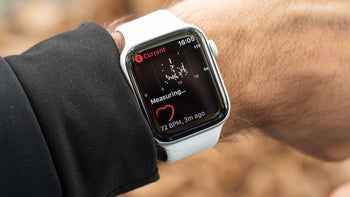Hidden code reveals that another life-saving feature is coming to the Apple Watch

You might recall that when Apple first unveiled the Apple Watch, it distributed the most expensive models through high-end jewelry stores. It also arranged to have certain fashion magazines run stories about the smartwatch with photos of models wearing them on their wrists. Eventually, Apple realized that perhaps this strategy was a mistake and started pulling the watch out of these snooty high-end stores.
It wasn't that the Apple Watch wasn't a success; in fact, it quickly became the most popular watch (not just the most popular smartwatch) in the world; its success has made Apple's Wearables division the company's fastest-growing unit (although the wireless Bluetooth AirPods earbuds have something to do with this as well). The manufacturer soon discovered that the heart rate monitor on the Apple Watch was saving lives, something that it dedicated an entire video to back in December 2018.
A new health-related feature could allow the Apple Watch to save more lives
At the same time that it released the video, Apple added a major new health feature to its timepiece. When it dropped watchOS 5.1.2, the company activated its new electrocardiogram (ECG) monitor. The ECG monitor looks for abnormal heart rhythms that could be a sign of Atrial Fibrillation (AFib); the latter can lead to blood clots, strokes, heart failure, and other heart-related problems. Just as the heart rate monitor has saved lives, the ECG monitor on the Apple Watch 4 and Apple Watch 5 has done likewise. And the manufacturer is looking to improve the feature.


Right now, the ECG will give a reading that is inconclusive if the user has a heart rate between 100 and 20 beats per minute (bpm). According to 9to5Mac, Apple will improve the ECG monitor on the Apple Watch and remove this restriction. Another life-saving feature on the Apple Watch is the fall detector that detects when an Apple Watch Series 4 or Series 5 owner falls. If the user is conscious, he or she can dismiss the alarm or tap to connect to emergency services. If the user is not conscious, emergency services are called automatically and a message to emergency contacts is sent with the location of the incident.
In addition, 9to5 Mac says that it was able to get an exclusive look at "snippets" of code from iOS 14 and discovered that the Apple Watch will soon have the ability to provide users with blood oxygen levels. Readings in the range of 95% to 100% are considered to be fine. Readings under 80% could indicate that a heart or brain problem is imminent. So Apple Watch users with a less than optimal reading, known as low blood oxygen saturation levels, will see a notification similar to the one that users with a high heart rate receive.
This is another important notification that Apple Watch users cannot simply ignore. Continued low blood oxygen saturation levels can lead to cardiac or respiratory arrest. It isn't clear whether this new feature will require certain hardware that Apple will add to the Apple Watch 6 or whether this fall's update to watchOS 7 will bring the blood oxygen readings to older models. The original Apple Watch reportedly has the capability of measuring this reading via the heart rate monitor. While Fitbit, which is being bought by Google, offers some of its users the ability to detect major changes in blood oxygen levels, what Apple is said to be planning is a more useful reading. It looks like the Apple Watch will have another way to save lives.
Also rumored to be coming to the next Apple Watch is a native sleep monitoring/tracking app; this is a missing feature that many have demanded from Apple. We could see the next Apple Watch unveiled in September along with the 2020 5G iPhone models.










Things that are NOT allowed: